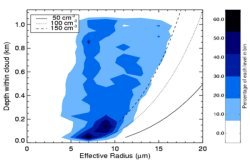Research Highlights
July 2007
Shallow Clouds Make the Case for Remote Sensing Instrumentation
Results: Findings from a recent study on cloud formation by Pacific Northwest National Laboratory researcher Sally McFarlane and collaborator Wojciech Grabowski show that thin, low-lying cumulus clouds are significantly diluted by mixing with surrounding dry air. The study also shows that mean cloud droplet size varied significantly relative to a droplet's height and position within the cloud. This level of detail is important for accurately representing cloud properties such as the cloud height, thickness, and depth, in climate models. The study also illustrates the utility of using remote sensing data to validate models of cloud microphysical processes—such as water condensation, evaporation, and conversion of cloud water to rain—which typically are used in studies concerning these shallow cumulus clouds. The team's recent findings are summarized in Geophysical Research Letters, a publication of the American Geophysical Union.
Why It Matters: Properties of shallow clouds, such as those examined by this study, play an important role in the Earth's energy balance. The effects of aerosols on clouds, particularly the influence of aerosols on cloud droplet size and distribution, are major sources of uncertainty in climate models. Modeling these effects requires assumptions about how clouds and their properties might be impacted by the mixing of dry and cloudy air. To constrain models, observations of the relationship between mixing and cloud droplet size are needed.
Traditionally, observations of air mixing and cloud droplet size come from in situ aircraft probes, which collect data at very high horizontal resolution. However, it is very expensive to sample numerous clouds with an aircraft, and measuring vertical profiles, especially in shallow clouds, is difficult. The use of remote sensing data allows analysis of significantly more cloud cases than would be possible, or practical, with aircraft data.

In this figure, the lines indicate theoretical calculations of cloud droplet size for clouds with various droplet concentrations in which no mixing occurs. The cloud droplet size shows significant variability with height. Enlarged View.
Methods: Data for this study were obtained from remote sensing instruments at Nauru, one of three ARM Climate Research Facility sites in the Tropical Western Pacific region. Using 6 months of data collected from shallow cumulus clouds, the researchers examined the size of individual water droplets that form clouds, in light of the amount of mixing with the dry air in the surrounding area.
What's Next: After analyzing the data collected from this study, the researchers hope to compare these results to datasets from Nauru during periods with significantly different conditions, such as El Niño and La Niña years, or from other ARM Climate Research Facility sites. Comparison of these data sets will contribute to the representation of optical properties, such as height of cloud and size/distribution of cloud droplets, in climate models. The science team also hopes to use data from this study to confirm existing models of cloud microphysical processes.
Acknowledgments: The research team included Sally McFarlane, Pacific Northwest National Laboratory, and Wojciech Grabowski, National Center for Atmospheric Research.
This work was supported by the Office of Biological and Environmental Research of the U.S. Department of Energy under contract DE-AC06-76RL01830 as part of the Atmospheric Radiation Measurement Program (McFarlane) and by NOAA grant NA05OAR4310107 (Grabowski).
Reference: McFarlane, S. A., and W. W. Grabowski (2007). Optical properties of shallow tropical cumuli derived from ARM ground-based remote sensing, Geophys. Res. Lett., 34, L06808, doi:10.1029/2006GL028767.

